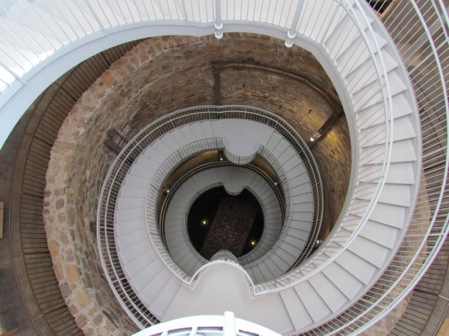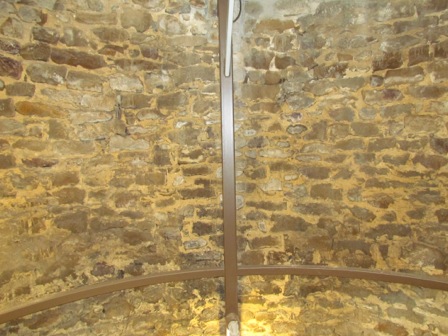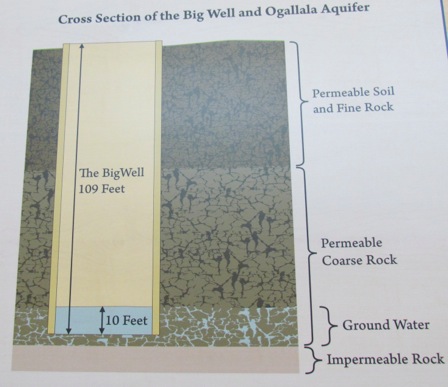Meanwhile we got some gas and saw this unique contraption gassing up too. I've seen what are called 'teardrop' RV's but I can't believe he sleeps in this.
 Hwy 54 was delightful: smooth (and in an RV we really notice the bumps), lonely (no one to pass and we didn’t have to pull off so people could pass us). Finally, the builders had designed the highway to bypass most of the small towns so it was pretty straight through. Although, some of the charm in taking the back roads is the small towns. Who knows what we might have seen in the ones we bypassed? In fact the next story is a perfect example of what we could have missed if the highway had bypassed Greensburg, KS.
Hwy 54 was delightful: smooth (and in an RV we really notice the bumps), lonely (no one to pass and we didn’t have to pull off so people could pass us). Finally, the builders had designed the highway to bypass most of the small towns so it was pretty straight through. Although, some of the charm in taking the back roads is the small towns. Who knows what we might have seen in the ones we bypassed? In fact the next story is a perfect example of what we could have missed if the highway had bypassed Greensburg, KS.
The claim to fame of Greensburg is the BIG WELL, the world’s largest hand-dug well. We had originally thought we’d stop to see this but as the day grew longer and Liberal seemed still a long ways away, we decided that the BIG WELL was something we could pass by. However, as we drove down the highway we saw a sign saying that the BIG WELL was only 3 blocks off the road. What the heck, we thought, let’s stop.
 We turned and drove down the street towards the BIG WELL and Museum but noticed that there were very few trees and what trees there were were either recently planted or topped off about 20’ up. Eerie. Then we noticed how much space there was between homes. Lots of empty lots. Suddenly it hit me: this was the small town in Southwestern Kansas which was devastated in 2007 by a tornado. Oh, yeah, look at all the new homes over there. And, over there, see the empty foundation with a driveway and a front sidewalk leading up to it. In fact, we learned later that we were on the very street that the tornado thought was a thoroughfare through the town.
We turned and drove down the street towards the BIG WELL and Museum but noticed that there were very few trees and what trees there were were either recently planted or topped off about 20’ up. Eerie. Then we noticed how much space there was between homes. Lots of empty lots. Suddenly it hit me: this was the small town in Southwestern Kansas which was devastated in 2007 by a tornado. Oh, yeah, look at all the new homes over there. And, over there, see the empty foundation with a driveway and a front sidewalk leading up to it. In fact, we learned later that we were on the very street that the tornado thought was a thoroughfare through the town.
Thus, the museum for the BIG WELL became the museum for the BIG WELL, the tornado and the rebuilding of Greensburg. First the BIG WELL. Greensburg started as the Cash Hopkins farm but then he and 2 friends enticed the stagecoach line owned by D. R. Green to come to town by naming the town after him. Now they needed citizens so they enticed the citizens of nearby Janesville to come to Greensburg by promising free lots, easy title purchase, free moving and free water from a public well. My, these 3 guys were good.
Here’s a picture of the museum on top of the big will with the steps going down in to it.
But, wait a minute the story gets even better. They’ve got a stage line, they’ve got people but now they need a post office to make it really official that this is a viable town. The post office was in Janesville, which was too close to warrant a second one in Greensburg. Aha, they got the postmaster drunk one night and moved the post office to Greensburg. Chicanery, thy name is Greensburg. Or maybe we can call this ingenuity. Poor Janesville. Probably didn't know what had hit them.
 The story of the World’s Largest Hand-Dug Well began in the 1880’s when both the Santa Fe and Rock Island Railroads were laying tracks across the plains of Kansas and needed a reliable water source. Towns scrambled to satisfy this need and in 1887, the city of Greensburg granted a franchise for a water works system to cost approximately $45,000, a huge sum of money in those days. They did not know it at the time but they were digging into the Ogallala Aquifer which, to this day, still supplies water to the Great Plains. (It is called upon to water 16 million acres of farmland in the Great Plains. Unfortunately, the rate of use is estimated to be 10 times the rate of replenishment.)
The story of the World’s Largest Hand-Dug Well began in the 1880’s when both the Santa Fe and Rock Island Railroads were laying tracks across the plains of Kansas and needed a reliable water source. Towns scrambled to satisfy this need and in 1887, the city of Greensburg granted a franchise for a water works system to cost approximately $45,000, a huge sum of money in those days. They did not know it at the time but they were digging into the Ogallala Aquifer which, to this day, still supplies water to the Great Plains. (It is called upon to water 16 million acres of farmland in the Great Plains. Unfortunately, the rate of use is estimated to be 10 times the rate of replenishment.)
The well was constructed with 1,160,000 lbs of stone quarried from a site about 12 miles away. At the actual site, 30 men, cowboys, farmers and transients in crews of 12 - 15 worked for 9 months for $.50 to $2.00 per day depending upon their job. They dug the well, braced it with wood and lined it with the rock. Their tools? pick axes, shovels, wheel barrows, pulleys and pails to lift the dirt removed. They then used the dirt to fill in the streets in town.
When the well was completed in 1888, it was 109 feet deep and 32 feet in diameter. It was used as the city’s water supply until 1932 when it was covered and opened as a historic attraction in 1937. And, there is the story of the BIG WELL.
The museum was pretty fascinating since it told the entire story of the tornado and its aftermath. We also stayed a bit to look at what Greensburg had made of itself after the tornado.
But that's a story for another blog.


No comments:
Post a Comment